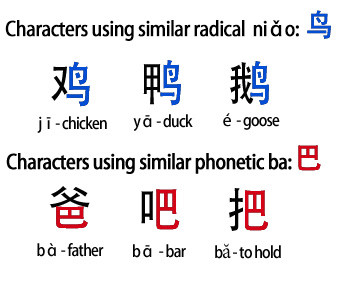Radicals: The Key to Maximizing Your Chinese Character Potential
By Lauren Pettit
By the time you reach this post, you’re probably well aware that Chinese is hard. Tones, measure words and homophones are just a few of the things that frequently perplex students – and that’s before you’ve even started learning to read and write.
So how do people do it?
Believe it or not, it’s possible. And it’s not as tricky as you might think – if you do it right, that is.
While it’s true that there’s no alphabet to guide you on your journey, there is a system that makes things a lot easier; it’s called the radical system, and it’s the key to maximizing your vocabulary recognition and retention rate.
To help you get the most out of each and every character you learn, we’re here to explain what radicals are, how they work and why you need to know them.
What are radicals?
 Known as 部首 (bùshǒu) in Chinese, radicals are graphical components of Chinese characters. Developed during the Ming Dynasty, they provide a way of grouping together and looking up characters in the dictionary – in the same way that we use the first letter of a word in English.
Known as 部首 (bùshǒu) in Chinese, radicals are graphical components of Chinese characters. Developed during the Ming Dynasty, they provide a way of grouping together and looking up characters in the dictionary – in the same way that we use the first letter of a word in English.
In total, there are 214 radicals, which form the basis of all 85,000 official characters.
Before you disappear in panic, note that you don’t need to know nearly that many to master Chinese. In fact, a knowledge of around 5,000 is enough to pass the HSK 6 exam and converse fluently.
So, why do radicals matter?
Sure, most of us ditched the dictionary in favour of Pleco long ago. But radicals still play a very important role in learning Chinese; besides acting as a dictionary reference, they also help learners draw a connection between words and take an educated guess at their meaning and pronunciation. In other words, they make Chinese easier.
The 214 radicals work as building blocks, combining with two or more others to form what’s known as a ‘compound character’ (形声 字 xíngshēngzì). Around 70-80% of these are constructed by both a semantic radical (义旁 yìpáng), and a phonetic radical (声旁 shēng páng):
Semantic: The 义旁 (yì páng) provides all or part of the meaning
Phonetic: The 声旁 (shēng páng) provides all or part of the character’s sound
While the majority of radicals must be combined with others to produce a meaning, others can work independently to form a complete word. For example, 口(kǒu), meaning ‘mouth’ is both a radical and a character in it’s own right.
Learning all of these radicals will equip you with a solid foundation of Chinese and prepare you to up your vocabulary game with ease.
Let’s look at some examples
Radicals can be found either on the left-hand side or the top of a character. Once you’ve got to grips with learning a few, you’ll soon spot them easily in new words.
In these examples, we will look at 青. Pronounced qīng, this is both a character on its own, as well as a radical. You’ll see it used as a radical in many different compound characters, where it’s combined with others to produce a new, but related meaning.
- 青 qīng – green
2. 请(qǐng) – to ask; to invite
Semantic radical: 讠yán – words
Phonetic radical: 青
3. 清(qīng) – clear
Semantic radical: 氵shuǐ – water
Phonetic radical: 青
4. 晴 (qíng) – sunny
Semantic radical: 日 rì – sun
Phonetic radical: 青
5. 情 (qíng) – emotion
Semantic radical: 忄xīn – heart
Phonetic radical: 青
Bear in mind that radicals have been adapted and simplified over hundreds of years from their original pictorial form. Therefore, not all examples offer an immediate logical connection; however, many do, and being able to recognize the semantic radical of a character will enable you to quickly deduce possible meanings from the myriad of options otherwise out there.
How important is it to learn radicals?
In short, very. Other methods of creating characters exist, but the radical system is by far the most common and therefore most important. Though it’s possible to dive right in and start learning characters without first getting to grips with them, you’ll soon realize your mistake when your classmates are racing through the vocab list much faster than you.
Take it from those who know best; Chinese children begin learning their written language through this very system. They start by mastering the simple, singular radicals that act as both 义旁 and 声旁 before progressing on to more complex characters.
This lays the foundation for reading more difficult texts and underpins their later knowledge of over 8,000 characters. Perhaps most notably for the impatient learners among us: it increases their learning speed.
A solid recognition of all 214 radicals will not only get your Chinese off to a good start, but it will make your path to fluency that bit easier. Besides, Mandarin is already hard enough – why make it even more difficult?
Stay tuned for our next article on radicals, where we’ll break down some more examples and show just how easy it is to learn written Chinese.
Ready to get started? Explore our online Chinese courses and learn with our certified teachers.